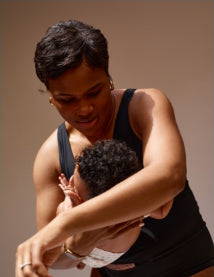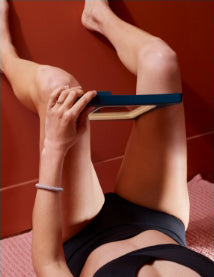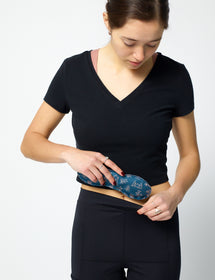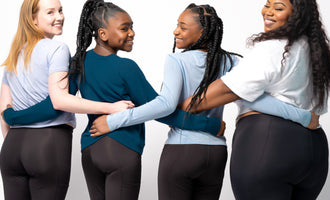Why Use Ice and Heat to Reduce Discomfort?
Authored by Nyssa and Cryotherapist Dr. Susan Kwiecien
If you have ever given birth or experienced period pain, you’ve likely used an ice or heat pack to help take the edge off of your discomfort. At Nyssa, we believe in the power of healing heat and cooling comfort to help care for women who need extra relief at home. Which is why we created our double-patented FourthWear® postpartum recovery underwear and VieWear™ everyday underwear intended to help women experiencing a range of below-the-belt issues, such as period pain, endometriosis, fertility treatments and recovery from pelvic/abdominal surgery.
ICE, ICE BABY
Ice therapy, traditionally known as cryotherapy, is an easy, inexpensive, and surprisingly effective approach for pain relief. Applying ice can help ease pain by reducing tissue temperature, which provides an acute local analgesic effect. It is through this reduction in temperature that cold application results in vasoconstriction and reduced blood circulation which can reduce edema, and limit hemorrhage formation. For these reasons ice can be an extremely useful tool in your recovery and for everyday pain management and to accelerate your recovery.
FourthWear® + Ice Pack:
Ice is most effective in reducing swelling and inflammation when used as soon as possible after pain begins. We recommend having FourthWear® and an ice pack on hand immediately after delivery, so that you can start experiencing the benefits that ice can provide as soon as possible after giving birth. Ice, in our FourthWear®, can be applied on a regular basis for no longer than 30-minutes at a time as needed, but ideally several times a day throughout the first 72-hours of your recovery. Complying with a rigorous (but safe) icing schedule, specifically during the first few days after giving birth, is likely to help you resume activities faster while being in better control of your pain.
Several studies aiming to assess perineal pain in women treated with a cold gel pad after delivery have revealed a decrease in the severity of postpartum perineal pain. A recent study 8910 titled ‘The Effects of Cold Application to the Perineum on Pain Relief After Vaginal Birth’ by 11 Derya K. Senol, Ph.D, RN and Ergul Aslan, RN showed that cold gel pad applied twice within the first 4 hours after vaginal delivery was more effective in relieving perineal pain in both primiparous (first-time mothers) and multiparous (those who have previously given birth) women, than in those who did not receive any cold application. Their study also showed that two applications of cold gel pad resulted in better overall recovery in daily activities such as lying down, sitting and walking, infant care, breastfeeding, and urination.
Applying a cold ice pack for 20 to 30 minutes, several times a day as needed following delivery, is also recommended as a treatment for the swelling and discomfort occurring as a result of hemorrhoids.
SOME LIKE IT HOT
FourthWear® + Heat Pack:
Afterbirth pains are similar to menstrual cramps, and occur the first few days following your baby's birth. They are normal, and may be stronger with each baby you have. They most commonly occur while breastfeeding. Warm heat packs and compresses can help with the pain. For pain from a cesarean section incision, a heating pad or warm compresses will ease the pain around your abdomen and incision (University of Rochester Medical Center).
_________________________________________
1. Mac Auley, D. C.
Ice therapy: How good is the evidence?
International Journal of Sports Medicine, 22 (5) (2001), 379–384.
https://doi.org/10.1055/s-2001-15656
2. Block, J.
Cold and compression in the management of musculoskeletal injuries and orthopedic operative procedures: a narrative review.
Open Access Journal of Sports Medicine, 1 (2010), 105
https://doi.org/10.2147/oajsm.s11102
3. Bleakley, C., McDonough, S., & MacAuley, D.
The Use of Ice in the Treatment of Acute Soft-Tissue Injury.
The American Journal of Sports Medicine, 32(1) (2004), 251–261
https://doi.org/10.1177/0363546503260757
4. Bleakley, C M, & Hopkins, J. T.
Is it possible to achieve optimal levels of tissue cooling in cryotherapy?
Physical Therapy Reviews, 15(4) (2010), 344–350
https://doi.org/10.1179/174328810x12786297204873
5. Algafly, A. A., George, K. P., & Herrington, L.
The effect of cryotherapy on nerve conduction velocity, pain threshold and pain tolerance * Commentary
British Journal of Sports Medicine, 41(6) (2007), 365–369
https://doi.org/10.1136/bjsm.2006.031237
6. Deal, D. N., Tipton, J., Rosencrance, E., Curl, W. W., & Smith, T. L.
Ice Reduces Edema.
The Journal of Bone and Joint Surgery-American Volume, 84(9)(2002)., 1573–1578
https://doi.org/10.2106/00004623-200209000-00009
7. Merrick, M A, & McBrier, N. M.
Progression of Secondary Injury after Musculoskeletal Trauma—A Window of Opportunity?
Journal of Sport Rehabilitation, 19(4) (2010), 380–388
https://doi.org/10.1123/jsr.19.4.380
8. S. Navvabi, Z. Abedian, M. Steen-Greaves
Effectiveness of cooling gel pads and ice packs on perineal pain
Br J Midwifery, 17 (11) (2009), pp. 724-729
http://hdl.handle.net/10034/88513
9. F. Jahdi, F. Sheikhan, K.E. Merghati, H. Haghani
The effect of cooling gel pad on the intensity of perineal pain following episiotomy
Arak Med Univ J, 13 (3) (2010), pp. 76-83
10. East, C. E., Begg, L., Henshall, N. E., Marchant, P. R., & Wallace, K.
Local cooling for relieving pain from perineal trauma sustained during childbirth.
Cochrane Database of Systematic Reviews, (5) (2012).
11. Senol, D. K., & Aslan, E.
The effects of cold application to the perineum on pain relief after vaginal birth.
Asian Nursing Research, 11(4) (2017), 276-282.
12. https://www.nwh.org/patient-guides-and-forms/postpartum-guide/postpartum-chapter-2/postpartum-care-pain-management
13. Watkins, A. A., Johnson, T. V., Shrewsberry, A. B., Nourparvar, P., Madni, T., Watkins, C. J., ... & Master, V. A.
Ice packs reduce postoperative midline incision pain and narcotic use: a randomized controlled trial.
Journal of the American College of Surgeons, 219(3) (2014), 511-517.
14. University of Rochester Medical Center
15. Dawood, M. Y.
Primary dysmenorrhea: advances in pathogenesis and management.
Obstet Gynecol 108 (2006), 428–441
https://doi.org/10.1097/01.AOG.0000230214.26638.0c
16. Proctor, M. & Farquhar, C.
Diagnosis and management of dysmenorrhoea.
BMJ 332 (2006), 1134–1138
https://doi.org/10.1136/bmj.332.7550.1134
17. Jo, J., Lee, S.H.
Heat therapy for primary dysmenorrhea: A systematic review and meta-analysis of its effects on pain relief and quality of life.
Sci Rep 8 (2018), 16252
https://doi.org/10.1038/s41598-018-34303-z
18. Whitaker LH, Reid J, Choa A, McFee S, Seretny M, Wilson J, Elton RA, Vincent K, Horne AW.
An exploratory study into objective and reported characteristics of neuropathic pain in women with chronic pelvic pain.
PLoS One. 2016;11(4):e0151950.
20. Armour, M., Sinclair, J., Chalmers, K.J. et al
Self-management strategies amongst Australian women with endometriosis: a national online survey.
BMC Complement Altern Med 19 (2019), 17
https://doi.org/10.1186/s12906-019-2431-x
21. Kuntz A.
Anatomic and physiologic properties of cutaneous-visceral vasomotor reflex arcs.
J Neurophysiol. 1945;8:421–9.
22. Akin M, Price W, Rodriguez G, Erasala G, Hurley G, Smith RP.
Continuous, low-level, topical heat wrap therapy as compared to acetaminophen for primary dysmenorrhea.
J Reprod Med. 49(9) (2004) :739–45.



